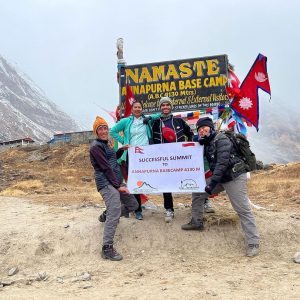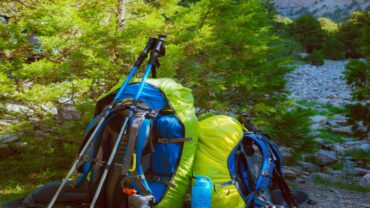Overview:
The Annapurna Base Camp trek in Nepal is a captivating journey that leads trekkers through diverse landscapes, from lush rhododendron forests and terraced fields to quaint villages inhabited by Gurung and Magar communities. The trek culminates at the base of the majestic Annapurna peaks, offering a breathtaking panorama of Himalayan giants like Annapurna I and Machapuchare. With a well-structured ascent for acclimatization, the trek combines cultural immersion, stunning scenery, and a sense of achievement. Trekkers often opt for experienced guides and support from tea houses, making the ABC trek an accessible yet unforgettable adventure. The best seasons for this trek are autumn and spring, and a commitment to environmental responsibility and cultural respect enhances the overall experience.

Essential steps to prepare for the Annapurna Base Camp trek
Nestled in the heart of the majestic Himalayas, the Annapurna Base Camp trek offers an unparalleled adventure for avid trekkers and nature enthusiasts. With its breathtaking landscapes, diverse flora and fauna, and rich cultural experiences, Annapurna Base Camp trek is truly a journey of a lifetime. However, to make the most of this extraordinary experience, thorough preparation is key. In this comprehensive guide, we’ll take you through the essential steps to prepare for the Annapurna Base Camp trek.
- Physical Fitness: Annapurna Base Camp trek demands a reasonable level of physical fitness. Begin by incorporating cardiovascular exercises such as hiking, jogging, or cycling into your routine. Strengthening exercises for your legs, core, and upper body will also prove beneficial. Aim for at least 30 minutes of moderate-intensity exercise at least 4-5 times a week.
- Cardiovascular Exercises: Include activities such as hiking, jogging, cycling, or swimming in your routine to improve stamina and endurance.
- Strength Training: Focus on leg muscles, core, and upper body to prepare for long, uphill treks and varied terrains.
- Altitude Acclimatization: Annapurna Base Camp the destination of Annapurna Base Camp trek sits at an elevation of about 4,130 meters (13,550 feet). Acclimatization is crucial to avoid altitude sickness. Consider incorporating high-altitude trekking in your training routine and gradually increasing the elevation. Plan your itinerary with adequate acclimatization days during the trek to allow your body to adjust to the altitude.
- Gradual Ascent: Acclimatize by gradually ascending to higher altitudes during your training hikes.
- Acclimatization Days: Incorporate rest days during your trek to allow your body to adjust to the decreasing oxygen levels.
- Gear and Equipment: Invest in high-quality trekking gear to ensure your safety and comfort during Annapurna Base Camp trek. Essential items include a sturdy pair of trekking boots, moisture-wicking clothing, a reliable backpack, a sleeping bag suitable for cold temperatures, and trekking poles. Don’t forget essentials like a hat, sunglasses, and sunscreen to protect yourself from the strong mountain sun.
- Trekking Boots: Invest in comfortable, waterproof, and ankle-supportive boots.
- Clothing: Opt for moisture-wicking, layered clothing to adapt to changing temperatures. Include a waterproof jacket and pants.
- Backpack: Choose a sturdy backpack with adjustable straps for comfort and weight distribution.
- Sleeping Bag: Select a sleeping bag suitable for cold temperatures at high altitudes.
- Trekking Poles: Help with balance and reduce strain on knees during descents.
- Trekking Permits and Documentation: Obtain the necessary permits for the Annapurna Conservation Area. Ensure your passport is valid for at least six months beyond your trek completion date. Keep photocopies of important documents, including your permits, in case of loss or emergency.
- Annapurna Conservation Area Permit (ACAP): Obtain this permit in Kathmandu or Pokhara.
- Trekkers’ Information Management System (TIMS) Card: Mandatory for all trekkers; available in Kathmandu or Pokhara.
- Vaccinations and Health Precautions: Consult with your healthcare provider for vaccinations recommended for travel to Nepal. Carry a basic first aid kit with essentials like pain relievers, altitude sickness medication, and any personal medications you may need. During Annapurna Base Camp trek stay hydrated and maintain good hygiene practices to prevent common travel-related illnesses.
- Consultation: Schedule a pre-travel health consultation with your healthcare provider.
- Vaccinations: Ensure you’re up-to-date on routine vaccinations and inquire about specific travel vaccines such as hepatitis A and B.
- Altitude Sickness Medication: Discuss the use of acetazolamide with your healthcare provider.
- Guides and Trekking Agencies: While it’s possible to trek independently, many opt for the services of a reputable trekking agency or guide. They provide valuable local knowledge, arrange permits, and ensure a smoother trekking experience. Research and choose a reliable agency that aligns with your preferences and budget.
- Research: Read reviews and testimonials to choose a reputable trekking agency.
- Guide: An experienced guide can enhance safety, provide cultural insights, and assist in emergencies.
- Cultural Sensitivity: Familiarize yourself with the local customs and traditions of the communities you’ll encounter during the Annapurna Base Camp trek. Respect the local culture, dress modestly, and seek permission before taking photographs of people or religious sites.
- Dress Code: Wear modest clothing, especially in religious sites and local villages.
- Photography Etiquette: Seek permission before taking photos of people and respect local customs regarding photography.
- Weather and Seasonal Considerations: The weather in the Himalayas can be unpredictable. Check the seasonal variations and pack accordingly. Autumn (September to November) and spring (March to May) are considered the best times for the Annapurna Base Camp trek due to clear skies and mild temperatures.
- Autumn: Clear skies, mild temperatures (September to November).
- Spring: Blooming rhododendrons, moderate temperatures (March to May).
- Prepare for temperature variations and possible rainfall.
- Training Treks: Prior to embarking on the Annapurna Base Camp trek, consider undertaking shorter training treks. This will not only help in gauging your fitness level but also familiarize you with the challenges of trekking at higher altitudes.
- Shorter Treks: Undertake day hikes or shorter multi-day treks to assess your fitness level and acclimatize to trekking conditions.
- Varied Terrains: Choose training routes with diverse terrains to simulate the conditions of the Annapurna region.
- Environmental Responsibility: Practice Leave No Trace principles by minimizing your impact on the environment. Dispose of waste responsibly, avoid single-use plastics, and respect the natural beauty of the trekking route.
- Leave No Trace: Pack out all waste, including biodegradable items.
- Say No to Single-Use Plastics: Carry a reusable water bottle and minimize the use of disposable items.
- Respect Wildlife: Observe animals from a distance and avoid disturbing their habitats.
In conclusion, meticulous preparation and attention to detail are crucial for a successful Annapurna Base Camp trek. By addressing these points, you’ll be well-equipped to tackle the challenges and savor the awe-inspiring beauty of the Himalayas. Preparing for the Annapurna Base Camp trek requires a holistic approach, encompassing physical training, proper gear, cultural awareness, and environmental responsibility. By dedicating time and effort to these aspects, you can ensure a safe, enjoyable, and fulfilling trekking experience in the breathtaking Himalayan landscapes. So lace up your boots, pack your bags, and get ready for the adventure of a lifetime!
Please Follow Us For more Updates :
Website : Base Camp Trip



Comment (0)